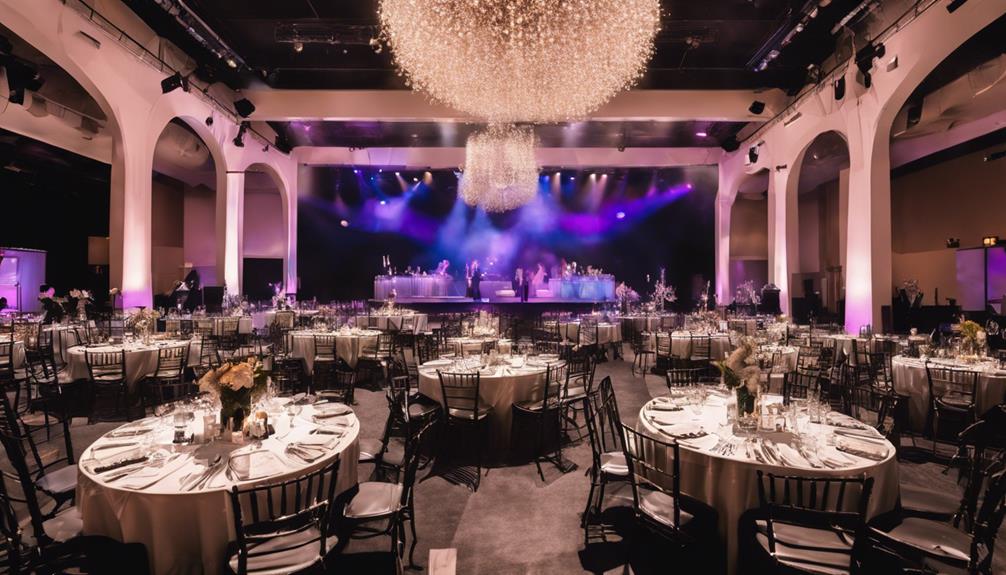To manage group conversations at noisy restaurants, keep your voice moderate and stay mindful of others by using clear speech and gentle gestures. Choose dishes and drinks that are easy to handle, and position yourself where everyone can see and hear better. Be patient, use technology like microphones if available, and suggest quieter areas if needed. For additional strategies to keep conversations flowing smoothly despite the noise, explore what else you can do.
Key Takeaways
- Make eye contact and use gestures to enhance understanding amid background noise.
- Choose a table with a clear line of sight to facilitate visual cues and communication.
- Lean in slightly and speak slowly to ensure your message is heard and understood.
- Use a microphone or portable speaker if available to improve sound clarity during conversations.
- Practice patience, humor, and positive body language to maintain a relaxed atmosphere despite noise challenges.

Dining out with a group at a noisy restaurant can be challenging, but with the right strategies, you can keep conversations flowing smoothly. The background noise makes it hard to hear everyone, so focusing on good table manners and smart ordering tips can make a significant difference. When it comes to table manners, remember to keep your voice at a moderate volume, avoiding shouting or speaking too loudly, which can disrupt others’ conversations. Being mindful of your eating habits also helps; chew quietly, avoid interrupting, and don’t forget to use proper utensils. These small courtesies create a more relaxed atmosphere and help keep the focus on the shared experience rather than on disruptive behavior.
Good table manners and mindful ordering help maintain smooth conversations in noisy restaurants.
In noisy settings, your choice of what to order can also impact your ability to participate in conversations. Opt for dishes that are easy to eat without making a mess or requiring a lot of cutlery, so you can focus on talking rather than managing your plate. If you’re ordering drinks or appetizers, consider selecting items that don’t require elaborate explanations or lengthy discussions, streamlining the process and reducing the time you spend ordering. When it’s your turn to place an order, keep your communication clear and concise. Speak directly to the server, enunciate your choices, and avoid waiting until the last minute, which can cause confusion or delays. This approach helps ensure everyone gets what they want without unnecessary back-and-forth. Additionally, choosing a high-quality microphone or speaker system can significantly improve communication in very noisy environments.
Also, be attentive to your fellow diners’ cues. If you notice someone struggling to hear or participate, lean in slightly, speak slowly, and repeat key points if needed. Making eye contact and using gestures can help convey your message more effectively. When the noise level is high, it’s wise to find a good spot at the table where you can see and be seen easily, making it easier to catch cues from others. If conversations become difficult, don’t hesitate to suggest a quieter area or ask the staff for a more suitable table if available.
Lastly, remember to practice patience and good humor. Everyone’s trying to enjoy the meal, and a little understanding goes a long way. With awareness of your table manners and thoughtful ordering tips, you’ll navigate group conversations expertly, turning a potentially chaotic experience into a memorable, enjoyable outing. Keeping communication respectful and clear enhances the fun for everyone, even amidst the noise.
Frequently Asked Questions
How Can I Politely Ask for Quieter Music?
When you want to politely ask for quieter music, start by choosing a friendly tone. You can use hand signals to subtly indicate the music is too loud, or politely say, “Could we turn the volume down a bit?” This approach shows respect and helps others understand your preference. Remember, using friendly gestures or words can make the request feel natural and considerate, ensuring everyone enjoys the meal.
What Are Effective Non-Verbal Cues During Loud Conversations?
In loud conversations, non-verbal cues are your best tools. Use hand gestures to signal you’re ready to speak or need a moment to listen. Maintain steady eye contact to show engagement and subtly indicate when the volume is too high. These cues help communicate your feelings without interrupting, making the conversation smoother and more respectful. Stay attentive to others’ signals, and you’ll navigate noisy chats more effectively.
How Do I Ensure Everyone Gets a Chance to Speak?
Think of your group conversation as a relay race, where each person passes the baton smoothly. You can guarantee everyone gets a turn by using turn-taking strategies and inclusive conversation techniques, like gentle hand signals or eye contact to signal when it’s their turn. Encourage quiet members to share their thoughts and be attentive. This keeps the dialogue balanced, making everyone feel valued and heard, even in noisy settings.
Are There Apps to Enhance Communication in Noisy Settings?
You can use voice amplification devices to make your voice clearer and easier to hear in noisy environments. Additionally, translation apps can help bridge language gaps and improve understanding among group members. These tools enable you to communicate more effectively without shouting or straining. By leveraging voice amplification and translation apps, you guarantee everyone stays engaged and connected, even amid the clatter and chatter of bustling restaurants.
How Can I Remember Everyone’s Names in Large Groups?
Remembering everyone’s names in large groups is like planting seeds in a garden—you need consistent care. Use name association techniques, linking each person’s name with a visual cue or characteristic. Repeat their name when you meet them, and try to connect it to a familiar word or image. This active effort boosts name recall, helping you remember names more naturally and confidently, even amid the noise.
Conclusion
Remember, the noise around you is just a backdrop—your focus is the melody of your friends’ voices. By leaning in, making eye contact, and using subtle cues, you can turn chaos into connection. Don’t let the clatter drown out your conversations; instead, let your attentiveness be the lighthouse guiding your group through the storm of sound. Embrace these tactics, and you’ll find that even in the loudest places, your words and bonds remain clear.











